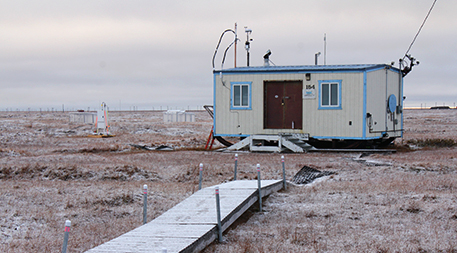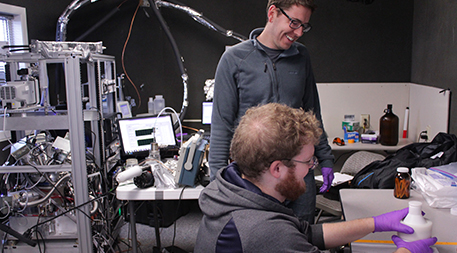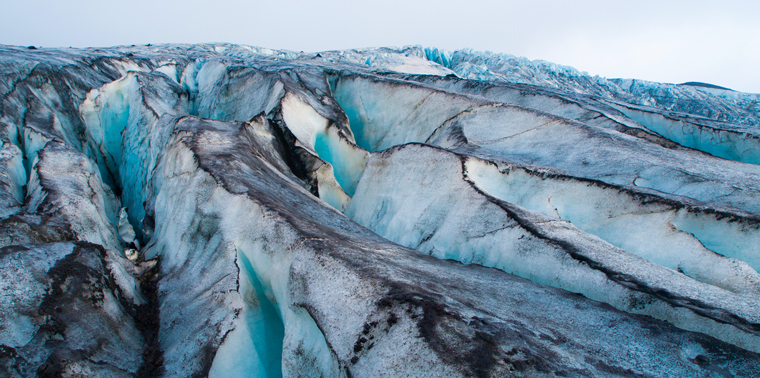May 17, 2017 — Editor’s note: Reporting for this story was supported by a grant from the Fund for Investigative Journalism.
On a morning in September 2015, sterile, gray Arctic light filtered through a blanket of woolly clouds as Matt Gunsch and Tate Barrett parked their rented pickup truck on a dirt road and clomped in rubber boots down a long, icy boardwalk to their air-monitoring laboratory on the tundra.
From the outside, the lab looked unglamorous — a dingy, white shack perched on a metal frame in a meadow speckled with snow and grass stubble. It felt distinctly like the middle of nowhere — though it was just a couple of miles beyond the main streets of Utqiaġvik, Alaska, the northernmost town in America. Inside the shack, a cracked window was patched with red tape. There was a shelf stacked with steel-toed and military-style “bunny” boots designed for extreme cold, tables scattered with miscellaneous lab supplies, a toaster oven — and hundreds of thousands of dollars worth of air-monitoring equipment whose internal motors filled the room with a constant high-pitched hum. Partially isolated from the dirt and exhaust of town, this turned out to be a good place to try to sniff out small intruders in the delicate Arctic atmosphere.
That summer and fall, Royal Dutch Shell was wrapping up the last of its offshore exploratory drilling in the Arctic (and would shortly announce its decision not to return). Environmentalists protested all summer and decried the potential for an oil spill — envisioning a catastrophe like the infamous Deepwater Horizon blowup of 2010, but on ice. Gunsch and Barrett, then Ph.D. students in atmospheric chemistry and environmental science respectively, were tracking a less dramatic but still insidious problem. They were searching the air for signs of black carbon, a type of air pollution also known as soot.

Scientists have been tracking sources of black carbon, a type of air pollution that contributes to climate change, in remote places like this laboratory in Utqiaġvik, Alaska. Here scientists Rebecca Sheesley, Kerri Pratt and their graduate students used state-of-the-art equipment to collect samples of Arctic air particles. Photo by Madeline Ostrander
Black carbon is a product of incomplete combustion from forest fires and the burning of both wood and fossil fuels, and its influence on the Arctic is like the proverbial death by a thousand cuts. At the top of the world, black carbon can land on snow and ice, darkening them, which makes them soak up more heat from the sun and melt faster. It can also absorb and radiate heat from sunlight as it floats through the atmosphere.Black carbon may be worsening the extreme warming felt all over the Arctic, record temperatures that are making permafrost disintegrate and sea ice melt. And if the Arctic gets too much warmer, it is, in the long term, like setting off a giant Rube Goldberg machine — once Arctic ice melts, seas rise; ocean waters absorb more heat; methane, another potent greenhouse gas, escapes from the permafrost.
The particles that end up in the Arctic have millions of points of origin, drifting northward from sources like wood and coal stoves used for cooking in India or diesel trucks chugging down U.S. highways. But any particles produced in the Arctic itself are far more likely to linger here and become a more damaging pollution problem.
As the melting Arctic becomes more accessible to ships and enticing for new development, some black carbon sources in the region are increasing. But there are only a handful of research stations monitoring the impact. The Arctic is a difficult place to do research — tough to reach and subject to extreme weather that can interfere with even the best-designed equipment. Utqiaġvik is one of about a half-dozen places in the entire high-Arctic region that are capturing ongoing data on soot.
Going Beyond Assumptions
Scientists had been making a lot of assumptions about how black carbon ended up in the Arctic — based on estimates and sophisticated models of global air masses. But few people had actually ventured out to the tundra to measure it themselves with this level of precision. And unless scientists and policy-makers knew where the problem was coming from, it would be tough to remedy it.
Inside Gunsch and Barrett’s lab in 2015, air was sucked in through a cone-shaped duct on the roof that sorted out particles — anything about a thirtieth of the width of a human hair and smaller could get through. A set of six foil-covered tentacles dangled from the ceiling, shunting the particles between several pieces of equipment designed to sort and measure them.
The most obtrusive of these was “Maverick,” named affectionately after Tom Cruise’s character in the movie Top Gun — a machine made of a complex assemblage of tubes, wires and metal and mounted onto an airplane cart. Gunsch and his supervisor, Kerri Pratt, a chemistry professor at the University of Michigan, had built Maverick by hand and shipped it to the Arctic. Inside Maverick were a set of tiny discs that had to be lined up with meticulous precision so that a laser could zap every microscopic particle at the precise moment it floated into the center of the instrument. As the laser exploded particles into fragments — kind of like “the Death Star [from Star Wars] blowing apart a planet,” Gunsch says — each gave off a unique signature, a fingerprint that could tell the researchers where in the world it came from.
Meanwhile, Barrett was working with Baylor University environmental science professor Rebecca Sheesley to collect the tiny specks that passed through another air sampler. Later, he and Sheesley would analyze them for the presence of radioactive carbon isotopes — in order to tell whether the soot came from ancient carbon (like fossil fuels) or newer sources (like forest fires).

In the 2015 field season, Tate Barrett (standing) and Matthew Gunsch spent their days gathering samples of air particles in the Alaskan Arctic using equipment such as “Maverick” (far left), a machine that records a unique signature for each air particle by zapping it with a laser. Photo by Madeline Ostrander
Despite the Space Age novelty of it all, it was tedious work. Gunsch and Barrett trekked back and forth several times a day between an old naval research station just off Utqiaġvik’s desolate, eroded beach road and the lab. They changed out thumb-sized filters made of aluminum foil, recorded weather data and crunched numbers. At night especially they kept an eye out for polar bears, although Gunsch had only ever seen a fox.
Buying Time
In the past decade, researchers have been racing to understand how much of a role black carbon plays in the global climate. It’s not a simple thing to answer: Black carbon is a complicated little substance, made of assorted molecules clumped together into particles of various sizes that can travel large distances and shape-shift as they interact with water, clouds, and chemicals.
Some scientists say black carbon could have an enormous impact on global warming, second only to carbon dioxide in its potency. Other experts think black carbon’s influence on the planet is smaller, but its effects on the Arctic itself could be noticeable. One study, published in 2015 in the journal Nature Climate Change, examined what might happen if the world reduced black carbon emissions (along with a few other more minor greenhouse gases) by about 60 percent — according to one of the authors — and made the most stringent cuts in the next 15 years. Under such a scenario, the Arctic could cool by as much as a 0.2 °C (0.36 °F) by 2050. That might sound small. But it’s a huge amount when you consider that 2 °C (3.6 °F) of atmospheric heat — a threshold long held up by several international authorities, including the United Nations Framework Convention on Climate Change — is often described as the brink of global catastrophe. And the hotter it gets up north, the warmer the rest of the planet becomes.
Though there is scientific uncertainty about its impacts, reining in black carbon could be a much more palatable political goal than tackling CO2. Globally, emissions of black carbon are already ramping down: In the U.S., for instance, they have dropped dramatically because of regulations on diesel engines.
And it could be relatively simple to cut back on the sources that are most damaging to the Arctic in particular. For instance, one of the worst culprits lies in the Russian Arctic — where natural gas plants burn off waste methane, sending black carbon into the skies. That problem could be curbed with low-cost technologies that capture the gas instead, and several countries — including Russia and the United States—have endorsed an international agreement to end routine gas flaring by 2030. Another problematic source could be curtailed with a mass effort to promote and distribute cleaner-burning woodstoves in northern latitudes and more efficient cookstoves in the developing world. This would also prevent hundreds of thousands of deaths from smoke inhalation.
In the global scale of things, black carbon’s impact is neither as important nor as long-lasting as that of CO2. But take a bit of soot out of the air, and the effects are almost instant.
The short lifespan of black carbon also makes it an appealing target: A particle of soot can live in the atmosphere for only about a week, whereas a molecule of CO2 can linger there anywhere from a few decades to many millennia. In the global scale of things, black carbon’s impact is neither as important nor as long-lasting as that of CO2. But take a bit of soot out of the air, and the effects are almost instant. “We’re very clear in acknowledging that CO2 is the 800-pound gorilla in the room,” says climate science professor Mark Flanner, an author of the Nature Climate Change study. “But … maybe through selective actions [on black carbon], you can buy yourself a little bit of extra time or slow the amount of warming that will occur within the next few decades.”
When black carbon is regulated, though, it’s often an afterthought. Under the Clean Air Act, the U.S. Environmental Protection Agency regulates black carbon as a component of “particulate matter”: Little particles are also a health hazard because they can penetrate human lung tissue, enter the bloodstream, and contribute to asthma, bronchitis, and heart and respiratory diseases.
But particulates are an overarching category that includes light-colored aerosols too, and not every effort to cut back on particles will also reduce black carbon. According to James Baumgartner, air regulator with the Alaska Department of Environmental Conservation, “the state of Alaska has no applicable emission standard specific to black carbon.” In 2012, the United Nations Economic Commission for Europe took on new standards to target black carbon as a component of particulate matter. Last fall, California pioneered a new law that requires a 50 percent cut in black carbon emissions by 2030.
Early in 2016 the Bureau of Ocean Energy Management released a proposed new rule for offshore air pollution standards for oil drilling in both Alaska and the Gulf of Mexico. The agency said it was also reviewing and researching means for controlling black carbon. But members of the oil industry oppose new offshore air standards, the Trump administration has torn down numerous other Obama-era environmental regulations, and the fate of this rule is uncertain. At press time, the rule was still under review.
In the past few years, there have been international efforts to come up with less scattershot ways of curbing black carbon. In April 2015, more than seven months before the Paris climate agreement, the eight nations and six indigenous organizations that sit on the Arctic Council — including the United States and Russia — quietly adopted a framework agreement to “take enhanced, ambitious, national and collective action to accelerate the decline in our overall black carbon emissions.”
It was a “groundbreaking agreement … the first time that the Arctic Council countries had taken action on climate change,” says Erika Rosenthal, a lawyer with the organization Earthjustice. At the same time, the U.S. took over the chairmanship of the Arctic Council, and then–Secretary of State John Kerry championed climate change and saving the Arctic as among his core missions. Later that year, Obama became the first president to travel above the Arctic Circle, and under U.S. chairmanship, the Arctic Council worked on a set of science-based recommendations for cutting black carbon emissions around the world.
New sources of black carbon are creeping into the Arctic as the ice thaws. Between 2008 and 2012, marine traffic in the U.S. Arctic went up 108 percent.
Much of that progress seemed up in the air as the Arctic Council gathered last week in Fairbanks to pass the rotating chairmanship on to Finland under Prime Minister Juha Sipilä. Speaking at that meeting, U.S. Secretary of State Rex Tillerson expressed reluctance to make any commitments on climate change: “We’re not going to rush to make a decision,” he said. It’s still not clear whether President Donald Trump will withdraw from the Paris Climate Agreement, though he announced recently that he’d withhold his decision until after the Group of Seven meeting in Italy later this month.
Despite all of that, the United States joined other Arctic nations in signing a pledge at the Arctic Council meeting that explicitly acknowledges how extreme and urgent Arctic warming is. The agreement, called the Fairbanks Declaration, adopts an “aspirational collective goal” to cut black carbon 25 to 33 percent by 2025. It’s less than what scientific models call for, but it is at least a concrete target.
“It’s not enough, but it’s a first step,” says Rosenthal.
Unanswered Questions
Meanwhile, new sources of black carbon are creeping into the Arctic as the ice thaws. Between 2008 and 2012, marine traffic in the U.S. Arctic went up 108 percent. In the summer and fall of 2016, the Crystal Serenity became the first luxury cruise liner to travel across the Arctic Ocean from Alaska to New York City. In late April this year, President Trump signed an executive order with the aim of reviving offshore drilling in the Alaskan Arctic and elsewhere, a move that prompted a lawsuit from several environmental groups. Oil companies are drilling more than a dozen exploratory oil wells in the Barents Sea off the coast of Norway. In the Russian Arctic, fossil-fuel companies have invested tens of billions of dollars in a massive drilling project that will ship liquefied natural gas from the Yamal Peninsula to Europe and other parts of Asia.
That means that more answers are needed urgently, and scientists are scrambling to fit the rest of the puzzle pieces together.
As such projects charge ahead, there are still many unanswered questions about how they will affect the Arctic’s air and climate. University of Michigan’s Pratt was surprised when her data revealed that the Prudhoe Bay oil field produced vast quantities of particles that were growing and could have an impact on cloud formation — a finding she and a group of collaborators reported in a paper in December 2016. Two years ago, Baylor’s Sheesley and Barrett, who is now a postdoctoral researcher at the University of North Texas, discovered that the major culprits dirtying Alaskan skies with black carbon in the winter lay in the North American Arctic (including Prudhoe) and the Russian Arctic — another surprise. Maverick, the particle “Death Star,” spent its second field season in 2016 at a remote U.S. Department of Energy research site, where Gunsch got a closer view of black carbon from Prudhoe.
“Maybe this oil field is having a greater impact than we thought,” says Pratt. And if that’s true, then putting more ships, rigs, roads, drills and well pads in the Arctic could have more serious consequences than climate scientists previously understood.
That means that more answers are needed urgently, and scientists are scrambling to fit the rest of the puzzle pieces together. Since 2015, three scientists — one with the U.S. National Oceanic and Atmospheric Administration, one at the University of Leeds, and one with the French Laboratoire Atmosphères, Milieux, Observations Spatiales, or LATMOS — have been bringing together groups of researchers from around the world to figure out how to shine a light on unexplained questions about black carbon. Charles Brock, a NOAA research physicist, is trying to organize a project with scientists from multiple agencies that would use research airplanes to track black-carbon pollution as it travels from China, Japan, and Korea to the Arctic. Much of the research on black carbon in the U.S. relies directly or indirectly on government funding whose fate could be tenuous under the Trump administration.
Meanwhile, the Arctic is rapidly unraveling. Since Pratt began her field work in Alaska five years ago, she’s has made several journeys into the waters of the Chukchi Sea and onto the sea ice with local guides in Utqiaġvik. “It’s actually pretty amazing. You can see the changes in the ice just in that time frame,” she said. “It’s quite shocking actually to see it firsthand.” ![]()
Ensia shares solutions-focused stories free of charge through our online magazine and partner media. That means audiences around the world have ready access to stories that can — and do — help them shape a better future. If you value our work, please show your support today.
Yes, I'll support Ensia!
